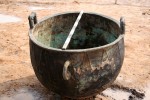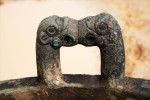 Last month, archaeologists excavating a mound in the Filippovka burial ground in the Orenburg region of Russia’s Southern Ural steppes discovered a rare intact burial from the nomadic Persian-speaking Sarmatian people who lived in the area from around 500 B.C. until 400 A.D. The burial ground has 29 funerary mounds, known as kurgans, almost all of which have been thoroughly excavated by archaeologists since the 1980s and thoroughly plundered by looters since antiquity. Archaeologists still work the site and have found important artifacts from Sarmatian daily life like hunting tools, household goods, but they thought there was no chance of finding any intact burials.
Last month, archaeologists excavating a mound in the Filippovka burial ground in the Orenburg region of Russia’s Southern Ural steppes discovered a rare intact burial from the nomadic Persian-speaking Sarmatian people who lived in the area from around 500 B.C. until 400 A.D. The burial ground has 29 funerary mounds, known as kurgans, almost all of which have been thoroughly excavated by archaeologists since the 1980s and thoroughly plundered by looters since antiquity. Archaeologists still work the site and have found important artifacts from Sarmatian daily life like hunting tools, household goods, but they thought there was no chance of finding any intact burials.
 Mound 1, aka the Tsar Tumulus, where the most recent discovery was made was excavated in 1986 and a large collection of jewelry, glassware, weapons and 26 stylized carved wooden dear covered in gold sheet was discovered. It became a signature treasure of the Sarmatian archaeology, giving historians a whole new understanding of the Iron Age nomads of the steppes, and has traveled to some of the world’s greatest museums. This summer the archaeological team from the Russian Academy of Sciences’ Institute of Archaeology returned to Mound 1 to explore the eastern section of the kurgan which the original excavation had overlooked. They had no expectations of discovering flashy artifacts; the goal was to find out everything they could about the mound and to determine how best to defend it from conservation threats.
Mound 1, aka the Tsar Tumulus, where the most recent discovery was made was excavated in 1986 and a large collection of jewelry, glassware, weapons and 26 stylized carved wooden dear covered in gold sheet was discovered. It became a signature treasure of the Sarmatian archaeology, giving historians a whole new understanding of the Iron Age nomads of the steppes, and has traveled to some of the world’s greatest museums. This summer the archaeological team from the Russian Academy of Sciences’ Institute of Archaeology returned to Mound 1 to explore the eastern section of the kurgan which the original excavation had overlooked. They had no expectations of discovering flashy artifacts; the goal was to find out everything they could about the mound and to determine how best to defend it from conservation threats.
 Instead, five meters (16.4 feet) under the surface in a passage near the entrance the archaeologists were welcomed by a cast bronze cauldron more than three feet in diameter with two looped handles on the sides and two top handles in the shape of griffins facing each other beak to beak. Underneath the mound they found the burial chamber, miraculously untouched with its human remains and artifacts lying exactly where they were left 2,500 years ago.
Instead, five meters (16.4 feet) under the surface in a passage near the entrance the archaeologists were welcomed by a cast bronze cauldron more than three feet in diameter with two looped handles on the sides and two top handles in the shape of griffins facing each other beak to beak. Underneath the mound they found the burial chamber, miraculously untouched with its human remains and artifacts lying exactly where they were left 2,500 years ago.
A small wicker chest that is thought to be a vanity case was found near the skull. It was filled to the brim with items including a cast silver container with a lid, a gold pectoral, a wooden box, cages, glass, silver and earthenware bathroom flasks, leather pouches, and horse teeth that contained red pigments.
Nearby lay a large silver mirror with gilded stylized animals on the handle and embossed decoration on the back with the image of an eagle in the centre, surrounded by a procession of six winged bulls.
The garments were decorated with several plaques, depicting flowers, rosettes and a panther leaping on a saiga’s (antelope) back. There were also 395 pressed pieces of gold leaf sewn onto the breeches, shirt and scarf. A fringed shawl was held together with a golden chain and the sleeves of the shirt were embellished with multicoloured beads, forming a complex geometric pattern. Two cast gold earrings decorated in places with cloisonné enamel were found in the area of the temporal bones.
They also found stone palettes, gilded needles, bone spoons and decorated pens that are thought to make up an ancient Sarmatian tattooing kit, a wooden bowls with gold handles shaped like bears, gold rings, a decorated glass vessel of Persian manufacture, a quiver of bronze-topped arrows and so much more. More than 1,000 artifacts were found in this one burial.
 Because of the wicker chest/beauty case, the mirror, bracelets, earrings and other jewelry, archaeologists initially thought the remains were of noble woman. Initial osteological analysis, however, indicates the skeleton belongs to male around 40 years old when he died. Only a DNA test can determine the sex of the person buried in this tomb of wonders.
Because of the wicker chest/beauty case, the mirror, bracelets, earrings and other jewelry, archaeologists initially thought the remains were of noble woman. Initial osteological analysis, however, indicates the skeleton belongs to male around 40 years old when he died. Only a DNA test can determine the sex of the person buried in this tomb of wonders.
Once the artifacts are fully cleaned, conserved, catalogued and studied, they will go on display in an Orenburg museum.